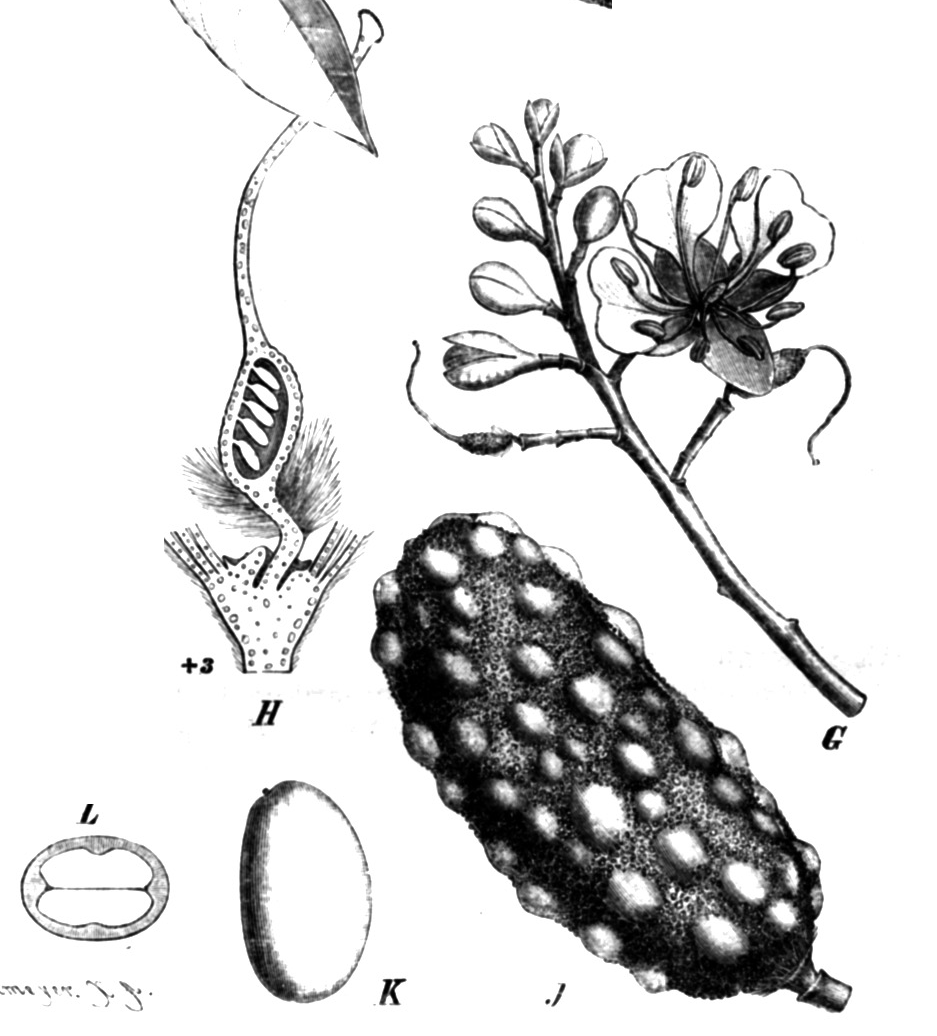- Hymenaea
image_caption = "Hymenaea verrucosa"
regnum =Plant ae
divisio = Magnoliophyta
classis = Magnoliopsida
ordo =Fabales
familia =Fabaceae
subfamilia =Caesalpinioideae
tribus =Detarieae
genus = "Hymenaea" L.
subdivision_ranks =Species
subdivision = "Hymenaea aurea " "Hymenaea courbaril" "Hymenaea eriogyne " "Hymenaea intermedia " "Hymenaea maranhensis " "Hymenaea martiana " "Hymenaea mexicana " † "Hymenaea oblongifolia " "Hymenaea parvifolia " "Hymenaea protera " † "Hymenaea reticulata " "Hymenaea rubriflora " "Hymenaea stigonocarpa " "Hymenaea torrei " "Hymenaea velutina " "Hymenaea verrucosa ""Hymenaea" L. is a
genus in thefamily Fabaceae (legume family). Of fourteen livingplant species in the genus, all but one are native to the tropics ofthe Americas , with one additional species ("Hymenaea verrucosa ") on the east coast ofAfrica . The genus is distributed through theCaribbean islands, and from southernMexico toBrazil . InColombia the trees are called "algarrobo", and inPeru "azúcar huayo". The Brazilian name is "jatobá ".Most species of "Hymenaea" are large
tree s and they are primarilyevergreen . They may grow to a height of 25meter s and emerge above theforest canopy. Some species will grow both as tall forest trees and as smaller shrubby trees depending on their surrounding habitat. The leaves are bifoliolate, meaning that they have twoleaflet s attached to the petiole. Theflower s grow in apanicle orcorymb type ofinflorescence .Uses and properties
The pulpy center of the
fruit s are edible and contain starch. The fruit is sold in local markets in the Americas. The leaves may be used to make atea . The trees produce a densewood used fortimber in making ships and furniture. The thick bark of some species is used by indigenous people of the Amazon to makecanoe s. Seeds contain large amounts (40% of dry weight) of a highly viscous polysaccharide (xyloglucan) which can be used in several industrical sectors such as food, paper, cosmetic and pharmaceutical.The trees also make hard
resin s that are used to manufacture varnish, especially the resin from "Hymenaea courbaril" (jatobá) in Brazil. The resin that is produced in Brazil is known asSouth America ncopal , and "Hymenaea verrucosa " is the source of the valuableZanzibar copal. Resin may be collected from living trees, or from the soil near the place where a tree once stood. Throughout its American range, indigenous peoples use the resin forincense and as a cement. Resin from the extinct species "Hymenaea protera " is the source ofDominican amber and probably of most amber found in the tropics.In the neotropical region, "
Hymenaea courbaril " has become an example of tropical tree plant species that responds to the globalclimatic changes in course in our planet. It increasesphotosynthesis by ca. 60% andcellulose by 30% when grown under 720ppm of CO2, the atmospheric concentration expected for the year 2100 ifcarbon dioxide (one of the maingreen house effect producing substances on Earth) emission continue to increase in the same rate.Seedling establishment is promoted byxyloglucan mobilization during development in "Hymenaea courbaril ". Seeds germinate after about 18 days and start xyloglucan mobilization after 45 days. This takes place for abuout 20 days, when photosynthesis is established and the seedling becomes independent.One of the signs that storage mobilization is occurring is that young leaves become red due to the presence of
anthocyanins .Seedlings from the rain forest invest 70% of their carbon in the aerial parts whereas the one from savannah invests more carbon (ca.70%) on root development.
Hymenaea is a very important species in programmes of recuperation of degraded Rain Forests in the
Neotropics . Regardingecological succession , Hymenaea courbaril appears late in the process being classified as a 'late successional' or climax species.See also
*
Dominican amber
* Animé, an oleo-resin from "Hymenaea" species.
*Jatobá , the economically important Brazilian tree "H. courbaril".References
* Aidar M.P.M., Martinez C. A., Costa A. C., Costa P. M. F., Dietrich S. M. C., Buckeridge M. S. (2002) Effect of atmospheric CO2 enrichment on the establishment of seedlings of jatobá, Hymenaea courbaril L. (Leguminosae, Caesalpinioideae) Biota Neotropica. 2(1):(http://www.biotaneotropica.org.br/v2n1/en/abstract?article+BN01602012002).
* [http://felix.ib.usp.br/pessoal/marcos2.htm] Buckeridge, M.S. & Aidar, M.P.M. (2002) Carbon sequestration in the rain forest: alternatives using environmentally friendly biotechnology. Biota Neotropica 2(1): (http://www.biotaneotropica.org.br/v2n1/en/item?point-of-view).
* Gentry, Alwyn H. (1996). "A Field Guide to the Families and Genera of Woody Plants of Northwest South America (Colombia, Ecuador, Peru)". Chicago: University of Chicago Press. ISBN 0-226-28944-3.
* Lima, D.U., Chaves, R.O. & Buckeridge, M.S. (2003) Seed storage hemicelluloses as wet-end additives in papermaking. Carbohydrate polymers 52:367-373.http://www.sciencedirect.com/science?_ob=ArticleURL&_udi=B6TFD-47WD89K-6&_user=10&_coverDate=06%2F01%2F2003&_alid=467430042&_rdoc=3&_fmt=summary&_orig=search&_cdi=5224&_sort=d&_docanchor=&view=c&_acct=C000050221&_version=1&_urlVersion=0&_userid=10&md5=ed9d7ea0f98ad90eddd946d7478fc693
* Lee, Yin-Tse & Langenheim, Jean H. (1975). "Sytematics of the Genus Hymenaea L. (Leguminosae, Caesalpinioideae, Detarieae)". University of California Publications in Botany 69.
* Mabberley, D. J. (1987). "The Plant Book: A Portable Dictionary of the Higher Plants". Cambridge:Cambridge University Press . ISBN 0-521-34060-8.
* Poinar, George Jr. & Brown, Alex E. (2002). "Hymenaea mexicana" sp. nov. (Leguminosae: Caesalpinioideae) from Mexican amber indicates Old World connections. "Botanical J. of the Linnaean Soc." 139(2): 125.
* Santos, H.P., Purgato, E., Mercier, H. & Buckeridge, M.S. (2004) The Control of Storage Xyloglucan Mobilization in Cotyledons of Hymenaea courbaril L. Plant Physiology 135:287-299.http://www.plantphysiol.org/cgi/content/abstract/135/1/287
* Santos, H.P. & Buckeridge, M.S. (2004) The Role of the Storage Carbon of Cotyledons in the Establishment of Seedlings of Hymenaea courbaril Under Different Light Conditions. Annals of Botany. 94(6) 819-830.http://aob.oxfordjournals.org/cgi/content/full/94/6/819
Wikimedia Foundation. 2010.

